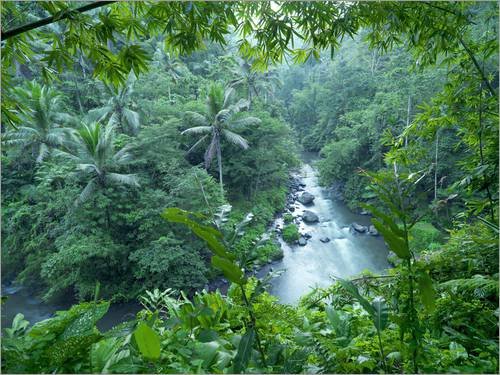
Tropical rainforests are home to over half the world’s species, all squeezed into a narrow strip of equatorial land. They are also home to millions of human beings that have been a part of forest ecosystem for thousands of years. Together, tropical forests form a gallery of the most beautiful, awe-inspiring places and creatures on Earth.
The Tropical Rainforest is a forest occurring in tropical areas of heavy rainfall. It is abundant with many species of wildlife and vegetation. Rainforests cover less than two percent of the Earth’s surface. They are home to some 50 to 70 percent of all life forms on our planet. Rainforests are the most productive and most complex ecosystems on Earth.
Tropical rainforests are located around the equator where temperatures stay near 80 degrees year round. Rainforests receive 160 to 400 inches (400-1000 cm) of rain each year. The largest rainforests are in Brazil (South America), Zaire (Africa) and Indonesia (South East Asia). Other tropical rainforest places are in Hawaii and the islands of the Pacific & Caribbean.
Tropical rainforests have long been home to tribal peoples who rely on their surroundings for food, shelter, and medicines. Today very few forest people live in traditional ways; most have been displaced by outside settlers, have been forced to give up their lifestyles by governments, or have chosen to adopt outside customs.
Of the remaining forest people, the Amazon supports the largest number of indigenous people living in traditional ways, although these people, too, have been impacted by the modern world. Nonetheless, indigenous peoples’ knowledge of medicinal plants remains unmatched and they have a great understanding of the ecology of the Amazon rainforest.

Children of the Forest: Africa’s Mbuti Pygmies
In Africa there are native forest dwellers sometimes known as pygmies. The tallest of these people, also called the Mbuti, rarely exceed 5 feet in height. Their small size enables them to move about the forest more efficiently than taller people.
There are few forest peoples in Asia living in fully traditional ways. The last nomadic people in Borneo are thought to have settled in the late 2000’s. New Guinea and the Andaman Islands are generally viewed as the last frontiers for forest people in Asia and the Pacific.
Only about half the forests in the tropics are rainforests. Rainforests only occur in places with high rainfall that are warm and frost free with little variation in temperature throughout the year . The tropical forests that are not rainforests are in places that have rainy and dry seasons, and the trees often drop their leaves in the dry season. Some forests in mountain areas may get snow and frost even though close to the equator.
A mature lowland tropical forest consists of several layers. The top layer of vegetation consists of scattered tall trees which tower above a closed canopy layer formed by the crowns of other trees. The canopy is the most exciting part of the rainforest; it is here that most of the flowering and fruiting of the trees takes place, attracting a variety of spectacular creatures.
Below the canopy is a third layer, formed by smaller trees whose crowns do not meet. Below that is a layer that’s composed of woody and herbaceous shrubs. Finally, there is the ground layer, which receives very little sunlight.
The “jungle” provided our ancient ancestors with a steady supply of wood, plants and animals, and it gave us many of our first fruits, fibers, grains, medicines, cloths, resins, pigments and other materials.It is undoubtedly one of the most fascinating interactions between climate, vegetation and organisms, and soil that exists in the world today.
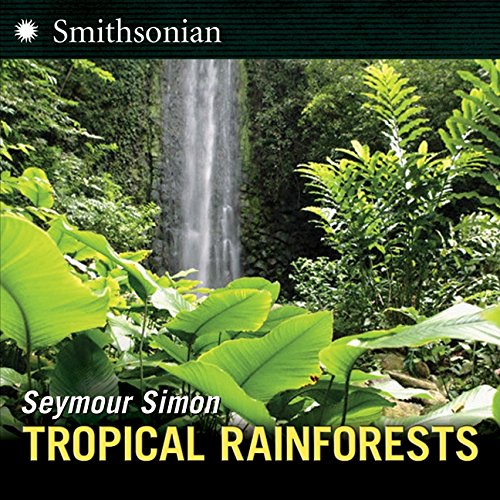
Within the confines of tropical rainforests are orchids, bananas, coffee plants and hundreds of rare and endangered animal species. These biomes, like other ecosystems on Earth, include an assortment of tiny microorganisms and bacteria. From the forest floor to towering canopies, plants and animals make themselves at home in all parts of the rainforest.
Tropical Animals
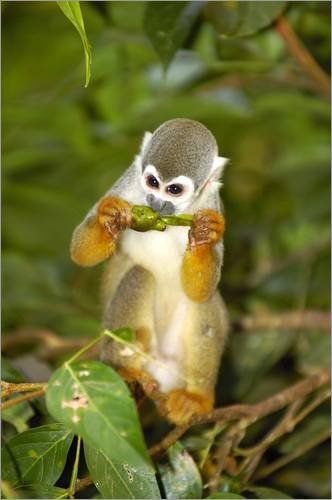
A huge number of animals live in rainforests, including microscopic animals, invertebrates (like insects and worms), fish, reptiles, amphibians, birds, and mammals. The different rainforests of the world support different populations of animals.
Different animals live in different strata of the rainforest.”Strata” means “layers.” Scientists divide rainforests into different strata (or layers) for easy reference. Each of these layers is a very different environment and supports different life forms.
These strata differ in many ways, including temperature, the amount of sunlight that they receive, the wetness of the environment, and the amount and types of life forms living in it.
Almost all of the worlds tropical rain forests lie close to the equator. These forests are known for their tall trees, dense vegetation, and for being humid and wet. There are four layers in a tropical rainforest biome (Forest Floor, Understory Layer, Canopy Layer, and Emergent Layer) and there are animals that have adapted to living in each one (or more) of these layers.
For example, birds live in the canopy (upper leaves of the trees) and in the emergents (the tops of the tallest trees). Large animals (like jaguars) generally live on the forest floor, but others (like monkeys and sloths) are arboreal (living in trees). Insects are found almost everywhere.
Tropical Plants
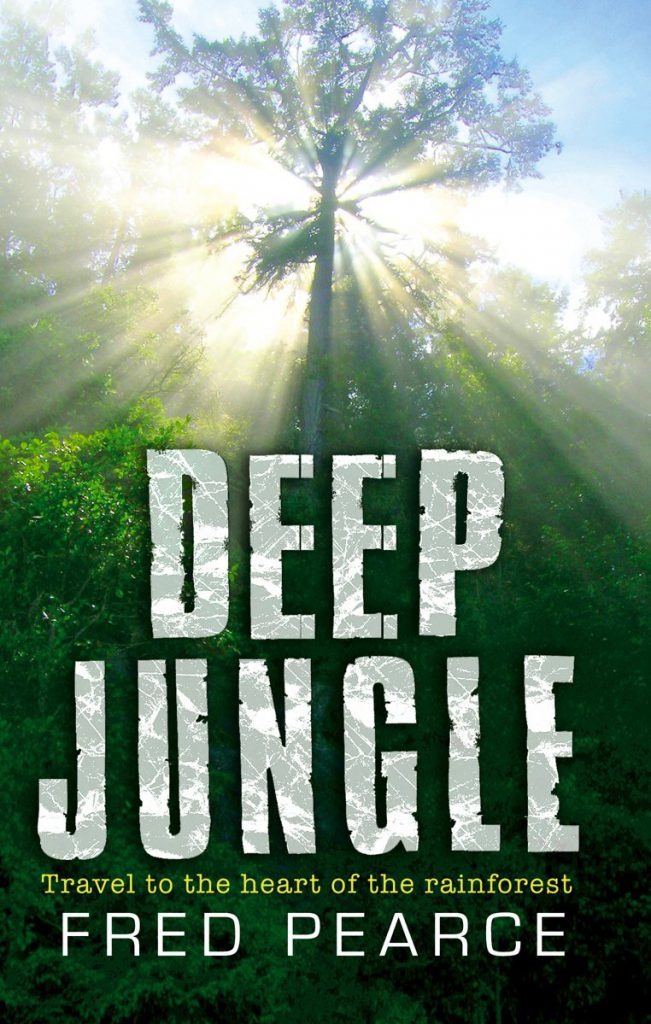
Deep Jungle: Journey To The Heart Of The Rainforest
The world’s tropical rainforests are home to an incredible number of plant species. The Amazon Rainforest alone contains overs 40,000 plant species!
The hot, humid climate in the world’s tropical regions provide ideal conditions for plant life.
However, there is a lot of competition for sunlight and nutrients. Plants have to adapt to find their place in the ecosystem.
More than two thirds of the world’s plant species are found in the tropical rainforests: plants that provide shelter and food for rainforest animals as well as taking part in the gas exchanges which provide much of the world’s oxygen supply.
Rainforest plants live in a warm humid environment that allows an enormous variation rare in more temperate climates: some like the orchids have beautiful flowers adapted to attract the profusion of forest insects.
Competition at ground level for light and food has lead to evolution of plants which live on the branches of other plants, or even strangle large trees to fight for survival.
The aerial plants often gather nourishment from the air itself using so-called ‘air roots’;. The humidity of the rainforest encourages such adaptations which would be impossible in most temperate forests with their much drier conditions.
Because of the incessant rain that beats down on the Amazon rainforest, soils are generally poor in nutrients. In such harsh environments, plants cannot afford the additional threat of being devoured by voracious insects. To defend themselves, they have evolved an amazing range of strategies and tools.
It is in the plants’ best interests to be tasteless, difficult to eat or just plain poisonous. So some plants have developed tough leaves, resins or latex outer coats that make them tough and able to resist many predators. Other plants produce leaves that are nutritionally poor, so insects have to invest a lot of time and effort in eating, which is not a worthwhile strategy for any species.
The most prevalent type of plant that is found in the tropical rainforest is the tree. Trees make up nearly two thirds of the rainforest plants that grow in the Amazon. There are larger trees, like the big leaf majogany, and it is actually 200 feet tall and can live to be 350 years old. It is deep in a reddish color, and it is used to make a lot of different types of furniture.
You will also find Brazil nut trees, which drop huge fruits around the beginning of each year. Their fruits are really large, and they can be produced only in Brazil.
It is also estimated that rainforests contain more than half of the fauna species on our planet. And yet deforestation of rainforests, especially of the Amazon, for human development and settlement threaten the millions of species that thrive in this unique world.
Here are just a small handful of the thousands of plant species in tropical rainforests.
Tropical Habitats
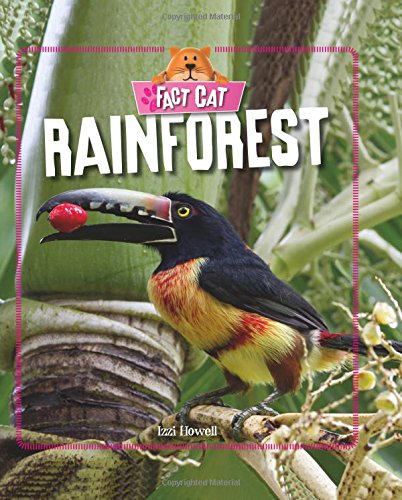
Rainforest (Fact Cat: Habitats)
Tropical rainforests represent the oldest major vegetation type still present on the terrestrial Earth. Like all vegetation, however, that of the rainforest continues to evolve and change, so modern tropical rainforests are not identical with rainforests of the geologic past.
Tropical rainforests today represent a treasure trove of biological heritage, and they also serve as sinks for more than 50 percent of all atmospheric carbon dioxide absorbed by plants annually.
Rainforests are perhaps the most endangered habitat on earth. Each year, some 140,000 sq km of rainforests are destroyed. Rainforests are being felled for timber by logging companies and cleared by people for farming. The most endangered rainforests are those in West Africa, where human populations are doubling every 20 years, and in Central America and South-East Asia.
Perhaps the most important step to protecting our rainforests is falling in love with them. Educate yourself, your family and your friends about the beauty and remarkable importance of these ecosystems. Right now forest destruction is more profitable than forest protection. You can change that, and a great place to start is arming yourself with the facts.
If you have any information,questions, or feedback you would like to include in this webpage.
Please email momo19@naturekingdoms.com or leave your comments below.
2 Comments
Wing
October 19, 2016 at 8:22 pmThe tropical rainforest and the Amazon has always mesmerized me. It’s such a fascinating part of our world. Although extremely dangerous in certain aspects, it’s also extremely intriguing. There are still so many things we can learn from the jungle: Animals, plants, indigenous tribes, etc. Still so much to explore!
momo19
October 20, 2016 at 4:09 pmHello Wing,
Tribal communities in the Amazon have a unique knowledge of a wide range of jungle plants and their medicinal uses and a drive to preserve this knowledge and share it with the world.
In the Amazon, when there is a problem such as building a new school or finding clean drinking water each household sends someone to help. Though its a brief interruption to whatever they were doing in their own lives, the volunteers come happily, people think and troubleshoot and sweat and toil together, and the problem is solved.
There isnt a place in the world so far removed from the hustle and bustle of modern life as the rainforest. Taking a boat ride, walking across rope-bridge or stopping by a cascade , these are all things that are good for the spirit. The rainforests of the world are rewarding and enchanting places to visit .